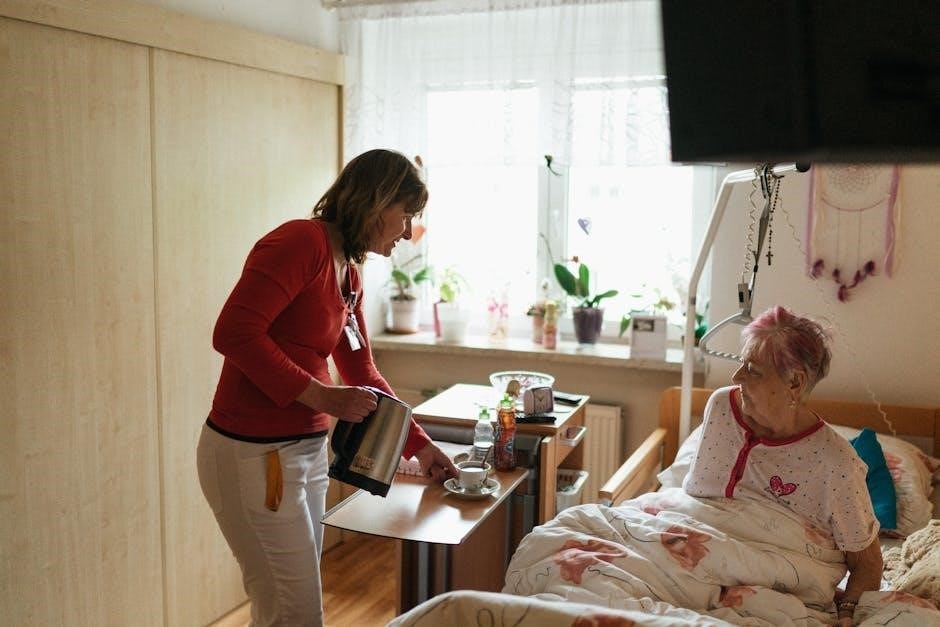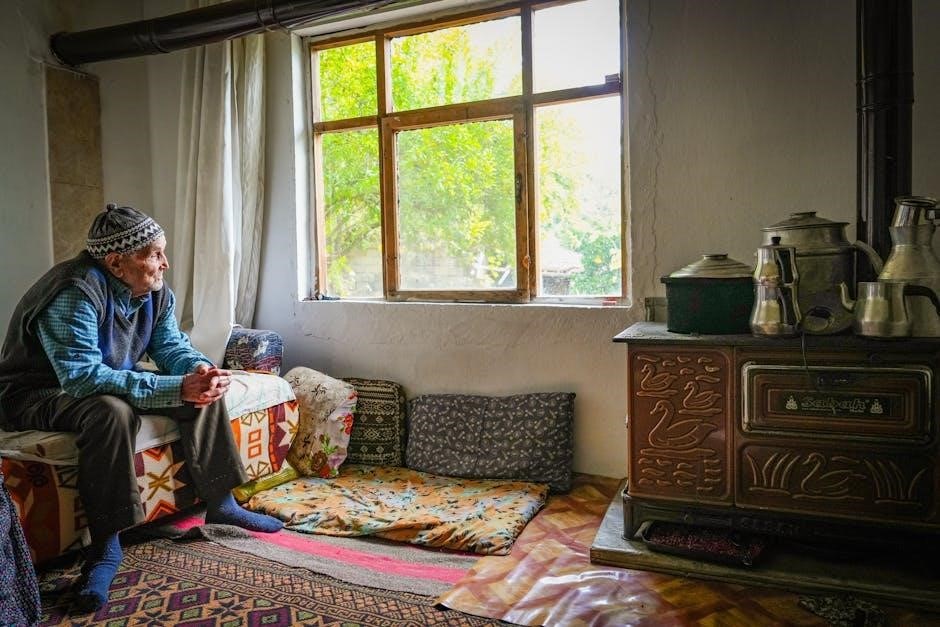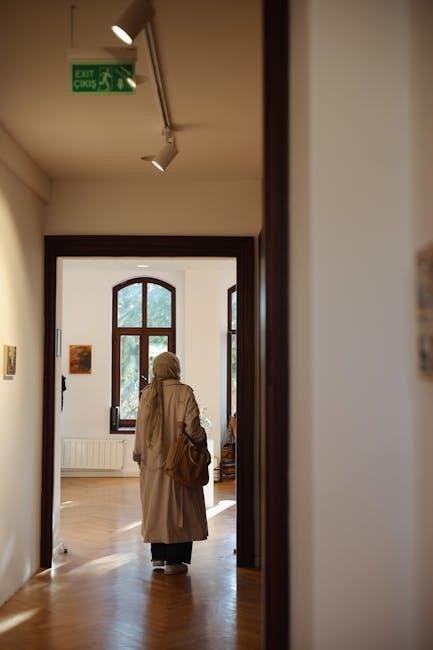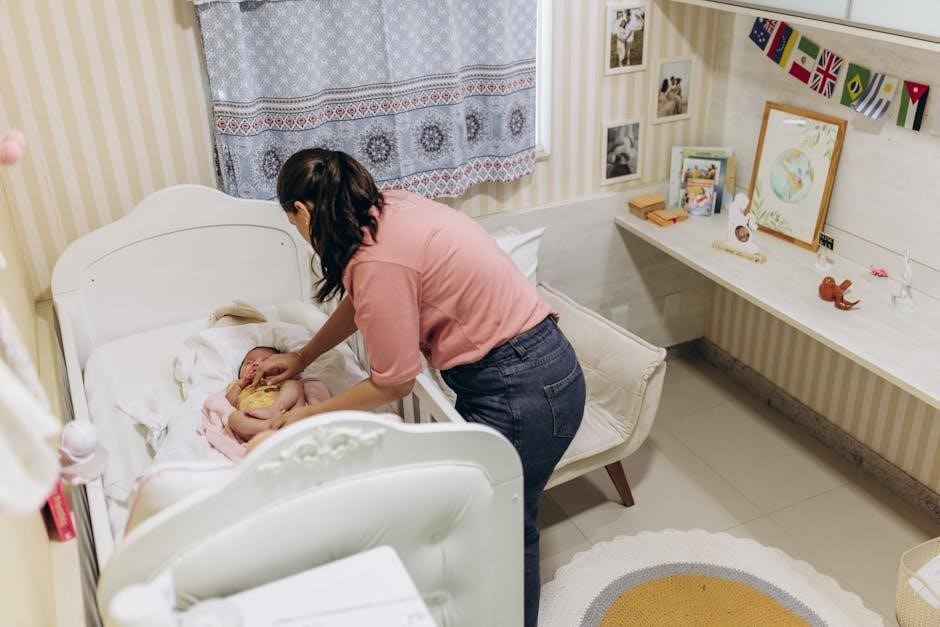Nursing escape room scenarios offer an innovative approach to clinical training, bridging theory and practice through immersive, problem-solving experiences, supported by structured resources and guides.
1.1. Definition and Purpose of Nursing Escape Rooms
Nursing escape rooms are interactive, immersive learning tools that simulate real healthcare scenarios, requiring participants to solve puzzles and challenges to “escape” within a time limit. These activities are designed to bridge theory and practice, offering hands-on experiences where nursing students and professionals can apply clinical skills, critical thinking, and teamwork. The purpose is to enhance knowledge retention, foster collaboration, and prepare learners for real-world patient care situations. By engaging in these activities, participants develop problem-solving abilities and decision-making skills in a controlled, risk-free environment, ultimately improving their readiness for clinical practice.
1.2. Importance of Interactive Learning in Nursing Education
Interactive learning is essential in nursing education as it actively engages students, fostering deeper understanding and retention of complex clinical concepts. Unlike traditional passive learning methods, interactive approaches like escape rooms encourage critical thinking, communication, and teamwork. These dynamic experiences simulate real-world healthcare scenarios, allowing students to apply theoretical knowledge in practical, high-pressure situations. By promoting active participation, interactive learning enhances problem-solving skills, clinical decision-making, and collaboration, all of which are vital for effective patient care. This immersive approach not only increases student engagement but also prepares future nurses for the challenges of modern healthcare, making it a valuable addition to nursing curricula.
Key Components of Nursing Escape Room Design
Nursing escape rooms require realistic scenarios, interactive puzzles, clear time limits, and educational tools to create immersive learning experiences that simulate clinical challenges and foster problem-solving skills.
2.1. Scenario Development for Nursing Contexts
Scenario development for nursing escape rooms involves creating realistic, clinically relevant challenges that align with learning objectives; These scenarios are designed to simulate real-world patient care situations, such as emergency responses or preoperative assessments, requiring students to apply theoretical knowledge. Educators and clinicians collaborate to ensure scenarios are accurate and engaging. Time limits and puzzle integration are carefully planned to mimic the urgency of healthcare settings. The goal is to foster critical thinking, teamwork, and decision-making skills while maintaining educational value. Scenarios are tailored to different skill levels, ensuring they are both challenging and achievable, promoting active learning and retention of nursing principles.
2.2. Puzzle Creation and Clue Placement
Puzzle creation and clue placement are critical in nursing escape rooms, ensuring challenges are both educational and engaging; Clues are hidden strategically to guide participants through scenarios, such as finding medication labels or solving riddles related to patient assessments. Puzzles are designed to test clinical knowledge, like calculating dosages or interpreting ECGs, aligning with curriculum objectives. Checklists and downloadable guides, such as those from the University of Kansas Health System, provide templates for designing these elements. Logical placement ensures a seamless flow, fostering critical thinking and teamwork. Each puzzle builds on the previous one, creating an immersive experience that reinforces nursing principles and clinical decision-making skills.
2.3. Time Limits and Team Collaboration
Time limits and team collaboration are integral to nursing escape rooms, enhancing engagement and mimicking real-life pressures. With typical durations of 45 minutes, participants must solve puzzles quickly, promoting critical thinking under duress. Teamwork is crucial, as tasks require diverse skills, encouraging effective communication and role delegation. This mirrors healthcare environments where nurses collaborate in teams. Time constraints heighten urgency, preparing students for high-stakes scenarios. Escape rooms foster cooperation and time management, effectively training future nurses in problem-solving and team-based care, ensuring preparedness for the demands of their profession and real-world challenges.

Benefits of Escape Rooms in Nursing Education
Nursing escape rooms enhance critical thinking, teamwork, and communication skills, offering engaging, real-world applications of clinical knowledge to prepare students for healthcare challenges effectively.
3.1. Enhanced Critical Thinking and Problem-Solving
Nursing escape rooms foster critical thinking and problem-solving by immersing students in scenarios requiring quick decisions and logical reasoning. Participants must analyze clues, prioritize actions, and adapt strategies to progress, mirroring real-world patient care challenges. The structured yet dynamic environment encourages creative problem-solving, as teams collaborate to uncover solutions; This active learning approach strengthens the ability to think critically under pressure, a vital skill for nurses in high-stakes healthcare settings. By engaging with complex puzzles and real-time challenges, students develop sharper analytical skills, preparing them to tackle diverse clinical situations effectively.
3.2. Improved Teamwork and Communication Skills
Nursing escape rooms significantly enhance teamwork and communication by requiring participants to collaborate effectively under time constraints. Students must share information, delegate tasks, and coordinate actions to solve challenges, fostering a sense of unity and mutual reliance. The dynamic environment demands clear communication to uncover clues and progress through scenarios, simulating real-life healthcare settings where teamwork is critical. Escape rooms encourage active listening, precise verbal instructions, and non-verbal cues, ensuring seamless coordination. Post-activity debriefs further allow students to reflect on their communication strategies, identifying strengths and areas for improvement. This collaborative learning method strengthens interpersonal skills essential for effective patient care and interprofessional collaboration.
3.3. Application of Clinical Knowledge in Real-World Scenarios
Nursing escape rooms provide students with practical opportunities to apply clinical knowledge in realistic patient care scenarios. By immersing learners in simulated environments, escape rooms replicate high-pressure situations, such as emergency responses or preoperative assessments, requiring students to use their clinical skills effectively. Puzzle-solving challenges often involve medication calculations, patient diagnostics, or safety protocols, ensuring that theoretical knowledge is translated into actionable steps. This experiential learning method allows students to practice decision-making and critical thinking in a risk-free setting, enhancing their ability to apply classroom learning to real-world patient care. The hands-on experience strengthens their clinical judgment and prepares them for the demands of healthcare professions.

Popular Nursing Escape Room Scenarios
Popular scenarios include emergency room simulations, operating room safety protocols, and patient assessment challenges, offering realistic clinical experiences for nursing students to practice critical skills effectively.
4.1. Emergency Room Simulation Scenarios
Emergency room simulation scenarios are high-stakes environments where nursing students navigate time-sensitive, life-threatening situations. These scenarios often involve mock code simulations, where students must quickly assess patients, prioritize care, and make critical decisions. Clues and puzzles are embedded to mimic real-life ER challenges, such as identifying symptoms, administering medications, or interpreting lab results. Teams must collaborate to unlock solutions, reflecting the fast-paced nature of emergency care. These simulations enhance decision-making, communication, and problem-solving skills, preparing students for the intensity of real-world emergency nursing. The immersive nature of these scenarios ensures active learning and retention of clinical knowledge in a dynamic setting.
4.2. Operating Room Safety Protocols
Operating room safety protocols are critical for maintaining patient safety and preventing complications. Nursing escape room scenarios often incorporate OR safety challenges, where students must adhere to strict protocols, such as proper hand hygiene, surgical site preparation, and instrument counting. Puzzles may involve identifying correct sterilization techniques or solving riddles related to medication administration. Time limits and clues add pressure, mimicking the high-stakes environment of real OR settings. These scenarios emphasize teamwork, attention to detail, and adherence to safety guidelines, ensuring students are well-prepared to handle surgical situations confidently and effectively. The immersive nature of these challenges reinforces proper OR protocols in a dynamic, interactive way.
4.3. Patient Assessment and Diagnosis Challenges
Patient assessment and diagnosis challenges in nursing escape rooms simulate real-world clinical scenarios, requiring students to evaluate symptoms, interpret vital signs, and solve puzzles to identify conditions. Clues are hidden in mock patient charts, lab results, or physician notes, prompting critical thinking and prioritization. Teams must collect and analyze data to unlock the next stage, mimicking the urgency of bedside decision-making. Tools like symptom checklists and abnormal lab result guides are often integrated. Time limits amplify the pressure, ensuring students practice efficient assessment skills. This activity enhances their ability to connect clinical findings with appropriate diagnoses, preparing them for accurate patient care in dynamic healthcare settings.
Tools and Resources for Designing Nursing Escape Rooms
Checklists, downloadable PDF guides, and the University of Kansas Health System’s Escape Room Guide provide structured tools to simplify escape room planning and design effectively.
5.1. Checklists for Escape Room Planning
Checklists are essential tools for organizing escape room scenarios, ensuring all elements are thoughtfully designed and implemented. They help educators outline objectives, scenarios, puzzles, and time limits, creating a structured framework. These checklists often include sections for topic selection, setting details, clue placement, and debriefing plans. They also guide the integration of clinical knowledge, such as preoperative patient assessments or skin antisepsis protocols. By following these checklists, facilitators can ensure a seamless experience, fostering critical thinking and collaboration among students. Additionally, checklists aid in evaluating the effectiveness of the escape room, allowing for continuous improvement based on student feedback and performance outcomes.
5.2. Downloadable PDF Guides and Worksheets
Downloadable PDF guides and worksheets are invaluable resources for designing nursing escape rooms. These materials provide step-by-step instructions, templates, and examples to streamline the planning process. The University of Kansas Health System offers a comprehensive guide, including worksheets for scenarios like preoperative patient assessments and safe patient transfers. These tools help educators create structured activities that align with learning objectives. Worksheets often include sections for defining scenarios, developing puzzles, and outlining debriefing processes. By leveraging these resources, nursing educators can efficiently design immersive learning experiences tailored to clinical training needs, ensuring engaging and effective escape room activities for their students.
5.3. University of Kansas Health System Escape Room Guide
The University of Kansas Health System offers a comprehensive, open-access PDF guide for designing escape rooms tailored to nursing education. This resource provides a “grab-and-go” approach, covering everything from initial planning to post-activity debriefing. It includes detailed checklists, worksheets, and scenario templates, such as those for preoperative patient assessments and safe patient transfers. The guide simplifies the design process, ensuring activities align with learning objectives and clinical competencies. Educators can use these tools to create immersive, problem-solving experiences that enhance nursing students’ critical thinking and practical skills. This guide is a valuable asset for developing effective escape room activities in nursing training programs.

Implementation of Escape Rooms in Nursing Training
Implementation involves a systematic approach, with facilitators guiding students through scenarios. Testing and refining scenarios ensure effectiveness, supported by detailed planning tools like the University of Kansas Health System’s guide.
6.1. Steps to Develop an Escape Room Activity
Developing an escape room activity involves defining learning objectives, creating a relevant scenario, and designing puzzles aligned with nursing competencies. Start by identifying the topic, such as patient assessment or medication safety. Next, outline the storyline and clues, ensuring they reflect real-world clinical challenges. Assign time limits to simulate pressure in healthcare settings. Test the activity with a small group to refine puzzles and ensure clarity. Incorporate feedback to enhance engagement and educational value. Finally, prepare facilitator guides and debriefing materials to maximize learning outcomes for nursing students.
6.2. Role of Facilitators and Debriefing Processes
FACILITATORS play a crucial role in guiding nursing students through escape room activities, ensuring alignment with learning objectives. They observe student interactions, provide subtle hints, and manage time limits. After the activity, facilitators lead debriefing sessions to discuss challenges, decisions, and outcomes. Debriefing involves reflecting on puzzle solutions, communication strategies, and clinical knowledge application. This process helps students identify strengths, areas for improvement, and the practical relevance of the scenarios. Facilitators also collect feedback to refine future activities, ensuring continuous improvement in both the escape room design and the educational experience for nursing students.
6.3. Testing and Refining Escape Room Scenarios
Testing escape room scenarios involves piloting the activity with a small group of students or faculty to identify strengths and areas for improvement. Facilitators observe participants’ interactions, puzzle-solving strategies, and time management to assess the scenario’s effectiveness. Feedback is collected to refine clues, adjust time limits, and ensure alignment with learning objectives. Iterative testing ensures scenarios are challenging yet achievable, promoting critical thinking and teamwork. Refinement may include simplifying complex puzzles, adjusting hint systems, or incorporating additional clinical nuances. This process enhances the educational value, ensuring scenarios remain engaging and relevant for nursing students while improving future iterations.

Real-World Examples of Nursing Escape Rooms
Examples include mock code simulations, preoperative patient assessments, and skin antisepsis challenges, providing engaging, real-world training scenarios that enhance clinical readiness and problem-solving skills for nursing students.
7.1. Case Study: Mock Code Simulation Escape Room
A mock code simulation escape room engages nursing students in a high-stakes environment, replicating real-life emergency scenarios. Participants must solve critical puzzles and unlock clues to “save” a patient within a time limit. This immersive experience enhances quick decision-making, teamwork, and adherence to protocols. Studies show participants achieved higher post-test scores, demonstrating improved knowledge retention. The simulation fosters practical application of skills, such as cardiac arrest management and medication administration. Facilitators observe and debrief, providing feedback to refine practices. This case study highlights the effectiveness of escape rooms in preparing nursing students for real-world emergencies, bridging the gap between theory and clinical practice effectively.
7.2. Example of a Preoperative Patient Assessment Scenario
A preoperative patient assessment escape room scenario challenges nursing students to evaluate a virtual patient’s readiness for surgery. Clues and puzzles focus on key areas like vital signs, medical history, and lab results. Students must identify potential risks, such as uncontrolled hypertension or medication interactions, to progress. The scenario includes timed challenges, requiring accurate documentation and prioritization of care. Success is measured by escaping within 45 minutes, demonstrating comprehensive assessment skills. This immersive activity enhances critical thinking and clinical judgment, ensuring students can apply nursing care principles effectively in real-world surgical settings. It provides a dynamic way to master preoperative protocols and patient safety measures.
7.3. Skin Antisepsis and Time-Out Protocol Challenges
Nursing escape room scenarios often incorporate skin antisepsis and time-out protocols to simulate real-world surgical safety measures. Students must identify and correct errors in antisepsis procedures, such as incorrect solution usage or incomplete preparation. The time-out process is a critical puzzle, requiring accurate verification of patient identity, procedure details, and surgical site marking. Clues hidden throughout the room guide students to adhere strictly to safety protocols. This scenario emphasizes teamwork and attention to detail, ensuring future nurses can prevent surgical site infections and maintain patient safety. Success is measured by completing the protocols accurately within the allotted time, reinforcing these critical steps in perioperative care.

The Role of Technology in Nursing Escape Rooms
Technology enhances nursing escape rooms by offering interactive simulations, realistic patient scenarios, and digital tools for immersive learning experiences, preparing students for clinical environments effectively.
8.1. Use of Digital Tools for Puzzle Design
Digital tools are integral to creating engaging puzzles in nursing escape rooms, offering interactive simulations, randomized solutions, and real-time feedback. These tools enable educators to design puzzles that align with specific clinical scenarios, such as mock code simulations or patient assessments. Software platforms allow for the integration of multimedia elements, like videos or audio cues, to enhance immersion. Digital tools also facilitate the creation of adaptive puzzles that adjust difficulty based on participant progress. For instance, online escape room builders provide templates and resources to streamline puzzle design. Such tools not only save time but also ensure puzzles are relevant, educational, and aligned with nursing competencies, enhancing the overall learning experience.
8.2. Integration of Simulation-Based Education
Simulation-based education (SBE) is seamlessly integrated into nursing escape rooms, offering realistic clinical scenarios that mirror actual patient care situations. This method enhances critical thinking, decision-making, and technical skills through immersive experiences. By combining SBE with escape room mechanics, educators create dynamic learning environments where students engage in hands-on problem-solving. For example, mock code simulations or emergency response drills can be embedded into escape room challenges, requiring teams to apply clinical knowledge under time constraints. This approach not only reinforces theoretical concepts but also builds confidence and competence, preparing nursing students for high-pressure real-world scenarios while ensuring patient safety and effective care delivery.
8.3. Virtual Escape Room Experiences
Virtual escape room experiences are revolutionizing nursing education by offering immersive, web-based learning environments. These digital platforms simulate real-world clinical scenarios, allowing students to engage in problem-solving and teamwork remotely. Virtual escape rooms provide flexibility, enabling asynchronous participation and accessibility for geographically dispersed learners. They often incorporate multimedia elements, such as videos and interactive puzzles, to enhance engagement. Additionally, virtual escape rooms can be easily updated with new scenarios, making them a cost-effective and sustainable option. This technology not only fosters critical thinking but also prepares nursing students for diverse clinical challenges through dynamic, technology-driven experiences, aligning with modern educational trends and learner preferences.

Assessment and Evaluation of Escape Room Effectiveness
Assessment and evaluation of escape rooms involve measuring knowledge retention through pre- and post-tests, collecting student feedback, and refining scenarios to enhance learning outcomes and curriculum development.
9.1. Measuring Knowledge Retention Through Pre- and Post-Tests
Pre- and post-tests are essential tools for assessing knowledge retention in nursing escape rooms. These evaluations measure students’ understanding before and after the activity, identifying gaps and improvements. By comparing scores, educators can determine the effectiveness of the escape room in reinforcing clinical concepts. For instance, studies show that participants in mock code simulations achieved higher post-test scores, demonstrating enhanced knowledge retention. This method provides actionable insights, allowing educators to refine scenarios and improve learning outcomes, ensuring that students apply theoretical knowledge in real-world situations effectively.
9.2. Feedback Collection from Nursing Students
Feedback from nursing students is crucial for refining escape room scenarios and improving educational outcomes. Surveys, focus groups, and debrief sessions are common methods for gathering insights. Students often highlight the engaging and motivating nature of escape rooms, emphasizing their ability to enhance critical thinking and teamwork. Feedback also reveals areas for improvement, such as puzzle clarity or time management. By analyzing student responses, educators can identify strengths and weaknesses, ensuring scenarios align with learning objectives. Positive feedback often underscores the practical application of clinical skills, reinforcing the value of escape rooms as a dynamic educational tool.
9.3. Improving Curriculum Based on Escape Room Outcomes
Escape room outcomes provide valuable insights for curriculum enhancement, ensuring nursing education remains effective and relevant. By analyzing student performance and feedback, educators can identify knowledge gaps and refine learning objectives. If escape room scenarios reveal consistent challenges, such as medication errors or patient assessment, the curriculum can be adjusted to emphasize these areas. This iterative process ensures that nursing training evolves dynamically, addressing real-world needs. Regular reviews of escape room results allow for targeted improvements, fostering a more comprehensive and adaptive educational experience for future nurses.

Future Trends in Nursing Escape Room Education
Future trends include expanding virtual/hybrid escape rooms, incorporating advanced clinical simulations, and enhancing interprofessional collaboration through immersive, technology-integrated learning experiences.
10.1. Expansion of Virtual and Hybrid Escape Rooms
The expansion of virtual and hybrid escape rooms is revolutionizing nursing education, offering remote accessibility and flexibility. These formats allow students to engage in immersive scenarios using digital platforms like Zoom or Google Forms. Virtual escape rooms integrate simulation-based education, enabling students to practice clinical skills in a risk-free environment. Hybrid models combine physical and virtual elements, enhancing realism. Tools like downloadable PDF guides from institutions such as the University of Kansas Health System facilitate seamless planning. This trend ensures that nursing education remains innovative, scalable, and adaptable to future challenges, preparing students for real-world clinical environments through dynamic, technology-driven learning experiences.
10.2. Increasing Focus on Interprofessional Collaboration
Nursing escape rooms are increasingly emphasizing interprofessional collaboration, mirroring real healthcare dynamics. These scenarios require students from diverse professions to work together, fostering teamwork and communication. By integrating roles like medicine, pharmacy, and therapy, escape rooms simulate authentic clinical environments where collaboration is essential. This approach helps students understand each profession’s responsibilities, enhancing mutual respect and trust. Interactive puzzles and challenges encourage open dialogue, ensuring all voices are heard. Such experiences prepare future healthcare providers to function effectively in multidisciplinary teams, ultimately improving patient outcomes. Interprofessional escape rooms are becoming a cornerstone of modern nursing education, bridging gaps between theory and practice.
10.3. Incorporation of Advanced Clinical Scenarios
Nursing escape rooms are evolving to incorporate advanced clinical scenarios, enhancing the complexity and realism of training. These scenarios simulate high-stakes situations, such as critical care emergencies or intricate surgical protocols, requiring students to apply specialized knowledge. By integrating advanced clinical challenges, escape rooms prepare students for rare and complex cases, fostering adaptability and expertise. For example, mock code simulations and high-fidelity patient assessment scenarios push learners to think critically and act decisively. These advanced scenarios also incorporate cutting-edge medical technologies, ensuring students are well-prepared for real-world practices. The University of Kansas Health System’s guide highlights the importance of such realistic simulations in nurturing clinical competence and confidence.
